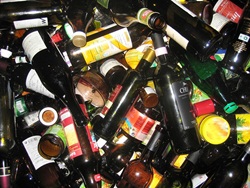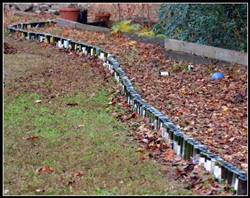![]()
TWO GARDENING TECHNIQUES TO REUSE WINE BOTTLES

According to a study by Innovative Green Solutions (IGS) in 2006, over 38 billion glass bottles were produced with approximately 12 percent of these bottles used for wines and spirits.
After two years, 2.81 million tons of glass bottles were recovered in recycling programs. This figure represents less than 30 percent of the glass bottles produced while the majority are discarded as rubbish, taken to the landfills and buried. Between eight and ten million tons of glass bottles are thrown away each year. These staggering figures are in the US alone, can you imagine how many are dumped by the rest of the world?
Recycling programs enable glass bottles to be processed into new products. They’re sorted by colour and melted down to make new bottles. Unfortunately however, this colour sorting process is not only very laborious but very expensive as well. Because of this dilemma, alternative solutions have to be considered for the future – it will become impossible to continue to bury everything we produce each year; more and more landfills reach capacity and are closed.
Four years ago, a known online wine retailer made a simple but progressive effort to help the environment by converting its small wine bottles into plastic packaging. Marks & Spencer has moved its range of 25cl wine bottles from glass to polyethylene terephthalate (PET) which saves 525 tonnes of packaging a year. Recycling and landfill waste aside, M&S plastic bottles are 88 percent lighter than the glass bottles and use less energy to manufacture. The lightweight bottle also means that lorries use less fuel in delivering the wines.
People who enjoy gardening can also upcycle glass wine bottles by using them in various gardening projects, such as garden edging and do-it-yourself herb gardens.

Garden edging
Garden or landscape edging is a permanent, hard material that supplies a crisp edge between areas of the garden. Using landscape edging accentuates each area and defines the shape and form of the overall design of the garden. A wide range of materials is suitable for landscape edging. The material you choose should be based on function, style, and cost. Instead of using wood, brick, concrete, rocks or stones, you can reuse wine bottles for this garden project. This garden edging can look pretty ingenious if you leave the wine labels on and allow them to weather off naturally.
DIY herbal garden
Another use for your empty wine bottles instead of throwing them in a recycle bin is to make a DIY herbal garden. This garden project is from an episode from HomeMade Modern. Here, Ben Uyeda shows us how to use wine bottles to create this unique feature with just some copper tubing, a glass cutter and Goo Gone. The use of safety gloves and goggles is highly recommended for this project. After you gather your supplies, it will be just minutes before you’ve created a place to grow your favourite greens inside or outside your home.
These remarkable environment-friendly garden projects would give you good excuses to drink up and be merry 😉

Dee Sewell – a horticulturalist and certified trainer who started Greenside Up in 2009 and teaches people how to grow vegetables. Dee specialises in working with community gardens but also offers workshops, allotment visits, consultations, horticultural therapy, afterschools clubs as well as local talks – she tailors her services to meet clients needs. In 2012 Dee launched a Seed Gift Collection containing varieties of vegetable and insect friendly flowers with the aim of getting more people growing. Dee’s blog was a finalist in the 2012 Ireland Blog Awards in the Eco/Green and Lifestyle Categories.




